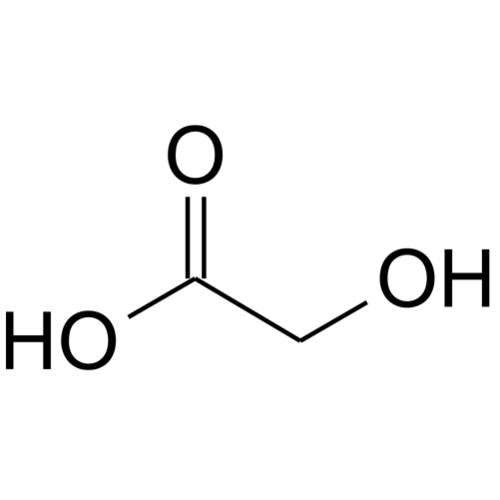
Glycolic acid
Scientific names: Hydroxyacetic acid
Alternate names: 2-Hydroxyethanoic Acid, Acide Alpha-Hydroxyéthanoïque, Acide Glycolique, Acide Hydroxyacétique (Acide Glycolique), Alpha-Hydroxyethanoic Acid, Hydroxyacetic Acid
Actions: General, Dermatological
Background
Glycolic acid is a type of alpha hydroxy acid (AHA). Alpha hydroxy acids are natural acids found in foods. Glycolic acid comes from sugarcane.
Alpha hydroxy acids like glycolic acid work by removing the top layers of dead skin cells. Glycolic acid also seems to help reverse sun damage to the skin.
People use glycolic acid for acne, aging skin, dark skin patches on the face, and acne scars. It is also used for stretch marks and other conditions, but there is no good scientific evidence to support these other uses.
Don't confuse glycolic acid with other alpha hydroxy acids, including citric acid, lactic acid, malic acid, and tartaric acid. These are not the same.
Alpha hydroxy acids like glycolic acid work by removing the top layers of dead skin cells. Glycolic acid also seems to help reverse sun damage to the skin.
People use glycolic acid for acne, aging skin, dark skin patches on the face, and acne scars. It is also used for stretch marks and other conditions, but there is no good scientific evidence to support these other uses.
Don't confuse glycolic acid with other alpha hydroxy acids, including citric acid, lactic acid, malic acid, and tartaric acid. These are not the same.
Safety Safety definitions
When taken by mouth: There isn't enough reliable information to know if glycolic acid is safe or what the side effects might be.
When applied to the skin: Glycolic acid is likely safe when used in products containing concentrations of 10% glycolic acid or less. But it is possibly unsafe when used in products containing higher concentrations. Concentrations of greater than 10% glycolic acid should only be used while under the care of a dermatologist. Using high concentration products inappropriately can cause serious skin reactions.
Sensitive skin: Glycolic acid can cause skin irritation and make certain skin conditions worse. Use cautiously in people with sensitive skin.
When applied to the skin: Glycolic acid is likely safe when used in products containing concentrations of 10% glycolic acid or less. But it is possibly unsafe when used in products containing higher concentrations. Concentrations of greater than 10% glycolic acid should only be used while under the care of a dermatologist. Using high concentration products inappropriately can cause serious skin reactions.
Special Precautions & Warnings:
Pregnancy and breast-feeding: Glycolic acid is likely safe when applied to the skin appropriately while pregnant or breast-feeding. But there isn't enough reliable information to know if glycolic acid is safe to use by mouth. Stay on the safe side and stick to topical products.Sensitive skin: Glycolic acid can cause skin irritation and make certain skin conditions worse. Use cautiously in people with sensitive skin.
Effectiveness
NatMed Pro rates effectiveness based on scientific evidence according to the following scale: Effective, Likely Effective, Possibly Effective, Possibly Ineffective, Likely Ineffective, Ineffective, and Insufficient Evidence to Rate.
Possibly effective Effectiveness definitions
- Acne. Applying glycolic acid to the skin seems to help reduce acne in people 12 years and older who have mild to moderate acne.
- Aging skin. Applying glycolic acid to the skin seems to reduce wrinkles and other signs of aging and sun damage.
- Acne scars. Applying glycolic acid to the skin, alone or together with microneedling, seems to reduce acne scars.
- Dark skin patches on the face (melasma). Applying glycolic acid to the skin, alone or together with other treatments, seems to reduce mixed-type and epidermal-type melasma. But it doesn't seem to help dermal-type melasma, which occurs in a deeper layer of the skin.
Dosing & administration
Glycolic acid has most often been applied to the skin by adults in lotions and creams containing glycolic acid 10% to 15% once or twice daily for up to 4 months. Short facial peels have also been used under the supervision of a healthcare provider. Speak with a healthcare provider to find out what type of product and concentration might be best for a specific condition.
Interactions with pharmaceuticals
It is not known if Glycolic Acid interacts with any medicines. Before taking Glycolic Acid, talk with your healthcare professional if you take any medications.
Interactions with herbs & supplements
There are no known interactions with herbs and supplements.
Interactions with foods
There are no known interactions with foods.
vital.ly has licensed monographs from TRC Healthcare.
This monograph was last reviewed on 16/01/2025 11:00:00. Monographs are reviewed and/or updated multiple times per month and at least once per year.
Natural Medicines disclaims any responsibility related to medical consequences of using any medical product. Effort is made to ensure that the information contained in this monograph is accurate at the time it was published. Consumers and medical professionals who consult this monograph are cautioned that any medical or product related decision is the sole responsibility of the consumer and/or the health care professional. A legal License Agreement sets limitations on downloading, storing, or printing content from this Database. No reproduction of this monograph or any content from this Database is permitted without written permission from the publisher. It is unlawful to download, store, or distribute content from this site.




